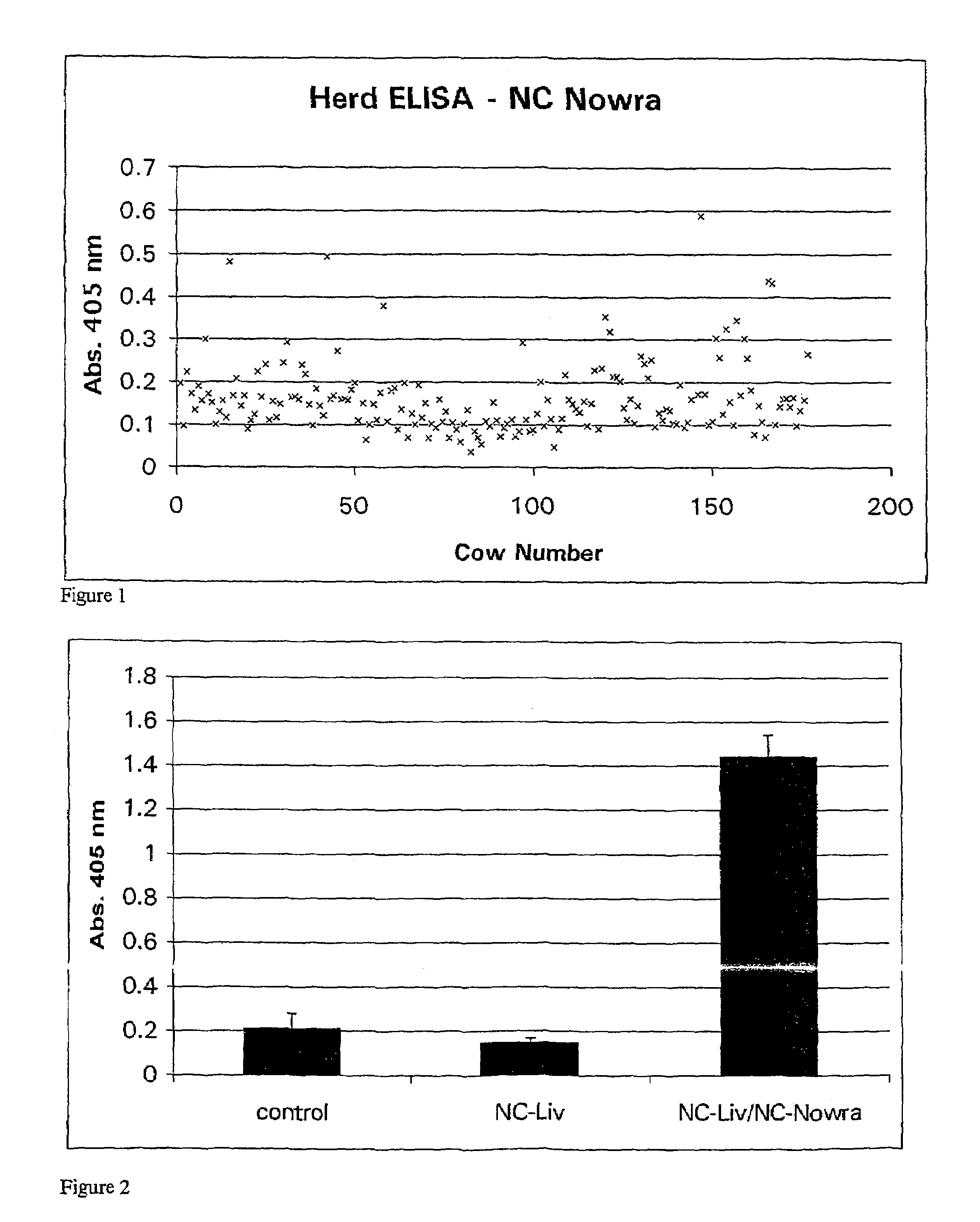Neospora caninum isolate
a protozoan isolate and extract technology, applied in the field of new parasitic protozoan isolates and extracts, can solve the problems of inability to formulate effective vaccines against transplacental transmission or foetal loss, and inability to obtain bovine isolates
- Summary
- Abstract
- Description
- Claims
- Application Information
AI Technical Summary
Benefits of technology
Problems solved by technology
Method used
Image
Examples
example 1
Isolation of Bovine Neospora sp. in New South Wales
[0061]The isolation and characterisation of a Neospora parasite from a clinically normal neonatal Australian Holstein-Friesian calf is described. The calf was born from a dam maintained in a commercial dairy herd of Holstein-Friesian cattle located on the south coast of New South Wales (NSW) Australia, near Nowra. This herd has been endemically infected with neosporosis for a number of years and has been studied extensively (Atkinson et al. 2000b). The dam was first identified as being serologically positive with an IFAT titre of 1280 for N. caninum in March 1995, having previously aborted in January 1994 but not since. The calf, which was seropositive to N. caninum antigen by western blotting, remained healthy and showed no clinical signs of N. caninum infection prior to it's euthanasia (NSW Agriculture) with intravenous potentiated pentabarbitone (EUTHETAL™) via jugular puncture with a 21 gauge needle and 20 ml syringe, dosed to e...
example 2
Characterisation of Isolated Organisms
[0066]Electron microscopy. Tachyzoites were recovered from in vitro culture and examined by transmission electron microscopy. Tachyzoites were fixed in 2.5% glutaraldehyde, 2% paraformaldehyde in phosphate buffer pH 7.2 for 2 hrs; washed three times with 0.1M cacodylate buffer and post-fixed in 1% aqueous osmium tetroxide. After excess fixative was removed by washing with water, parasites were dehydrated in ethanol, transferred to anhydrous acetone and infiltrated and embedded in Epon resin. The blocks were cut and ultrathin sections examined with a JEM 1010 transmission electron microscope. Tachyzoites were identified as N. caninum by virtue of their size, shape and internal structures including the presence of characteristic intracellular organelles such as electron dense rhoptries (Speer et al. 1999).
[0067]Western blotting. Tachyzoite lysates of Nc-Nowra, Nc-Liverpool and the ME49 strain of T. gondii were analysed by western blotting using se...
example 3
Nc-Nowra Tachyzoites Used in a Serological Test such as an ELISA
[0069]A dairy herd, located in the Southern Highlands of NSW, contained 177 Friesians with a history of abortion, with 37 abortions being recorded over 18 months spanning 1999 / 2000. There were two dogs and numerous foxes on this property, and N. caninum was previously diagnosed on the property by post mortem examination of aborted foetuses by NSW Agriculture. The herd is regularly and fully vaccinated against leptosporidiosis. The dairy herd was bleed for routine investigation of the cause of the abortions and these sera were screened for antibodies to Nc-Nowra using an indirect ELISA protocol developed at UTS and described below.
[0070]Nc-Nowra tachyzoites were recovered from in vitro culture and reduced to protein extracts by resuspension in lysis buffer (20 mM Tris pH 7.5, 150 mM NaCl, 1% TRITON™ X-100, 1 mM PMSF, 2 mM DTT, 1 mM benzimidine HCl) and disruption by sonication at 50W / 20 KHz for 10-20 secs. The resulting ...
PUM
| Property | Measurement | Unit |
|---|---|---|
| concentration | aaaaa | aaaaa |
| concentration | aaaaa | aaaaa |
| concentration | aaaaa | aaaaa |
Abstract
Description
Claims
Application Information
 Login to View More
Login to View More - R&D
- Intellectual Property
- Life Sciences
- Materials
- Tech Scout
- Unparalleled Data Quality
- Higher Quality Content
- 60% Fewer Hallucinations
Browse by: Latest US Patents, China's latest patents, Technical Efficacy Thesaurus, Application Domain, Technology Topic, Popular Technical Reports.
© 2025 PatSnap. All rights reserved.Legal|Privacy policy|Modern Slavery Act Transparency Statement|Sitemap|About US| Contact US: help@patsnap.com

